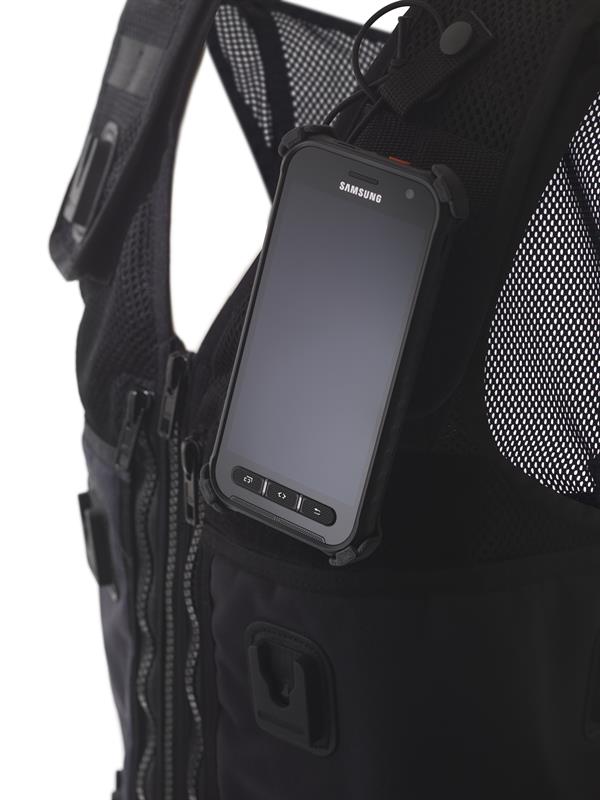The demonstration took place using a beta release of the BSR1 software drop, which contains a lot of the core functionality required by ESN users. Calls were made between EE in Bristol and the Ricoh Arena in Coventry (BAPCO 2018’s venue).
Matt Hall, solutions architect at EE, explained that all the pre-emption and priority capabilities, together with intelligent access class barring capabilities were present and that the latter was tested during the Notting Hill carnival.
Simon McCutcheon, head of service governance at Motorola Solutions, explained that as his company’s team in Basingstoke received the first ESN devices from Samsung two weeks ago, the hardware/software integration “is not there yet”, though it was sufficient for the demonstration.
He showed the apps that will be used to access ESN’s core services: PSX Cockpit, which will allow users to sign into the other ESN applications; PSX PTT, for PTT calls; PSX Messaging, PSX Secure Calling, which allows end-to-end encrypted duplex telephony as a VoIP call over LTE, with pre-emption and priority. With the PSX PTT app, when a call is being made it shows the call sign of a person making a call and the number of people in the communications group (ESN’s equivalent of talk groups, given that the same groups are used for sharing messages and images). The app is used for both group calls and “point-to-point” calls.
All of the above, with the exception of PSX Cockpit, were demonstrated. Call setup times and latency seemed fast, with ESMCP's deputy director Steve Whatson suggesting that when it comes to voice, TETRA and LTE will be comparable from an end user perspective. It took longer for image messages to be received, and it was explained that performance in this area will be enhanced in the BSR4 software drop.
Features which are still to come include REGA (ESN’s equivalent of Dynamic Group Number Assignment – DGNA – which allows a network operator or authorised user to dynamically allocate new, or update existing talk groups to selected terminals over the air interface), enhanced emergency call, group and individual video, status messaging, public telephony, ambient listening, TETRA interworking and control room capabilities.
Nick Ross, head of criminal justice and public safety, Samsung Electronics UK, described the ESN handset’s features, such as its IP68 rating, MIL-STD-810G compliance (it has been designed so that it can survived being accidentally dropped onto hard surfaces), PTT and emergency buttons. The three buttons that in a standard android smartphone sit at the bottom of the screen and are used to navigate between applications are physical buttons in this device, allowing easier use when wearing gloves. The battery can be swapped out in the field and Samsung has fitted the device with its largest capacity battery to date (4,500 milliamps).

Similarly, the LED indicators for Bluetooth and power statuses were moved to the top of the device making them clearly visible when glancing down. He added that this change was made in four weeks, when it would normally take six months, and said that Samsung wants to continue to receive feedback so it can keep fine-tuning the device to meet the needs of public safety users.
EE’s Hall said that the programme is not currently implementing Evolved Multimedia Broadcast Multicast Services (eMBMS), as the standards are not there yet. They will however be reviewing it. Staying on the subject of standardisation, Whatson continued by stating that part of the Home Office’s contract with Motorola Solutions includes a roadmap to the mission-critical LTE standards being developed in 3GPP.
Whatson added that feedback from users in relation to the current test has been universally positive and that they now want to take it out to end-users. Land Mobile heard similar sentiments from user organisations who had already attended previous, similar, demonstrations, with the idea that this would be a great way to reduce end-users’ concerns and build enthusiasm.
In response to a question about why the ESN device doesn’t have an external antenna, Whatson explained that given the number of bands that must be supported, the complex antenna elements need to be very tightly bonded to the CPU to prevent signal loss. In the case of a vehicle solution, there’s the option to boost the signal to compensate for this, but this currently isn’t permitted in the UK, so the Home Office is currently in discussions with Ofcom to get this changed.
Whatson expects the amount of extra data that ESN will enable user organisations to consume to vary, noting that ambulance services are already very data-centric. He noted that one or two police services are already streaming body-worn video footage and if the rest follow, then overall data usage will rise dramatically. In response to a question about how TETRA’s Direct Mode Operation feature will be replaced, he explained that conversations are still ongoing with user organisations and that while it is only an issue for a subset of users, it is vital for those that use it.
It was explained that BSR4 is likely to be the software drop that will be the starting point for any incremental delivery. Call recording capabilities will be the responsibility of the individual user organisations.
Also at BAPCO 2018, Stephen Webb, director, law enforcement programmes at the Home Office announced that Bryan Clark will replace Gordon Shipley as the ESMCP programme director. Shipley is stepping down from the role at the end of this month. Clark was appointed director, digital and change, at the National Offender Management Service (NOMS) in March 2015 and has worked in technology for more than 30 years including 15 years as partner & European CIO of KPMG and more recently CEO of Sumerian Europe Ltd.



